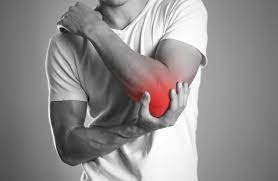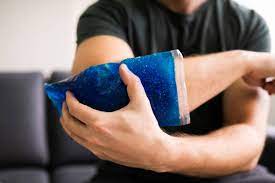How to Deal with Tennis Elbow

Lateral epicondylitis, more commonly referred to as tennis elbow, is a painful condition when the tendons in your elbow become overloaded, usually due to overuse—specifically, repeated wrist and arm motions, like swinging a tennis racket. Although despite the name, this injury is not limited to athletes. Plumbers, carpenters, painters, and many other physically demanding jobs involve motions that can lead to tennis elbow. These repeated motions can lead to inflammation and even tearing in the tendon that connects the forearm muscles to the outside of the elbow.
Causes
Just one tendon connects the forearm muscle to the bony bump on the outer elbow. Tennis elbow occurs when the tendon becomes overloaded and inflamed, leading to degeneration and potentially even tearing. When we perform repetitive arm movements, like swinging a tennis racket, our forearm muscles get tired. So as the forearm muscle gets tired, the tendon takes on more of the load. When the tendon is overloaded, it becomes inflamed and painful, which is what we call tennis elbow. Over time and repeated overloading, there can even be tearing in the tendon.
Symptoms and Diagnosis
The pain that comes with tennis elbow usually occurs where the forearm tendons connect to the outside of your elbow and may radiate into your forearm and wrist. It may also become more difficult to grip objects or turn door knobs. If self-care steps like rest, ice, and over-the-counter pain medications don’t ease your pain, you should contact your doctor. Your doctor may recommend a physical exam where they may apply pressure to the affected area and ask you to move your arm in various ways. In most cases, your physical exam and medical history provide enough information for your doctor to make a diagnosis.

Physical Therapy
Often, tennis elbow will get better through at-home remedies like rest, ice, and over-the-counter pain medications. But if these self-care measures are not working, your doctor may recommend physical therapy. First, a physical therapist can evaluate you to determine the best steps. After an evaluation, your physical therapist will develop a plan to best help you improve your strength and flexibility to reduce pain and promote healing. For example, your physical therapist will teach you exercises to strengthen your forearm muscles while improving their flexibility. They may also recommend wearing a forearm brace to help reduce stress. If your symptoms have not improved after 12 months of physical therapy and non-operative treatment, you may need surgery to remove the damaged tissue.
Featured Clinician: Anthony Maritato, PT
FEATURED CLINICIAN: Anthony Maritato, PT Anthony Maritato, PT, MSPT, is a licensed physical therapist and co-founder of Total Therapy Solutions, a private practice outpatient physical therapy business that focuses on
Colleen Rapp Wins Friend of Private Practice Award
Long time patient advocate, Colleen Rapp, was awarded the APTA Private Practice Section’s Friend of Private Practice Award during the 2022 PPS conference. Colleen has long been standing up for
Top Tips for Relieving Nerve Pain
Top Tips for Relieving Nerve Pain If you suffer from nerve or neuropathic pain, then you can certainly attest to how it can throw a wrench in your day-to-day routine.
How Your Diet Can Cause Inflammation
How Your Diet Can Cause Inflammation Depending on the situation, inflammation can be a good thing or a bad thing. It is good in that it is your body’s way
What to Avoid After Knee Replacement Surgery
What to Avoid After Knee Replacement Surgery Knee arthroplasty, otherwise known as knee replacement surgery, is designed to relieve pain and restore function in severely diseased knee joints. No matter
How Physical Therapy Can Help You Avoid Reliance on Pain Medications
How Physical Therapy Can Help You Avoid Reliance on Pain Medications If you suffer from chronic pain, you know how managing pain can be a real challenge. Another day, another
Kyle Yancey
Latest posts by Kyle Yancey (see all)
- Top Tips for Relieving Nerve Pain - October 28, 2022
- How Your Diet Can Cause Inflammation - October 25, 2022
- What to Avoid After Knee Replacement Surgery - October 19, 2022
- How Physical Therapy Can Help You Avoid Reliance on Pain Medications - October 13, 2022
- Physical Therapy for Heart Disease - October 11, 2022
